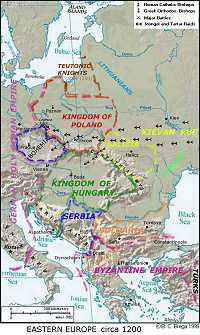 |
Two Thousand Years of the Modern Era in Eastern Europe Part 2: 11th to 13th Centuries - Crusaders Destroy Byzantium. |
Bill Biega's History Essays |
|
Biega Home Page
Consulting Using special characters. East Europe Cities, Countries, Info. History Genealogy, History Essays Maps Cities, Countries, Historical Photo Gallery Places I visited Rydzyna Sailing all over the world Syrena Press 13 Is My Lucky Number Learning LINUX 
Contact us by Email |
Click on any illustration with colored border to see it full size. Then click on "Back" button to return to this page.
During the Second Millennium of the Modern Era, peoples moved very little. In other words, the nations residing today in various territorial areas are the same ones that lived there a thousand years ago, speaking basically the same languages and going to the same churches. This is remarkable when one considers the great political changes that have occurred during this period.
In Poland, the son of Mieszko, Boleslaw I, the Brave , consolidated the new Polish state and expanded it to include Moravia and most of Ruthenia. He even entered Kiev in 1018. None of the Slav peoples had a clear cut rule of succession. Therefore, upon his death, his sons squabbled. The Germans (Brandenburg) took advantage of this weakness and grabbed most of Pomerania, almost cutting off access to the Baltic Sea. The Bohemians recovered Moravia and annexed Silesia. The main unifying element in the next two hundred years were the bishops. Another Boleslaw, called the Bold, briefly reunited the kingdom and was crowned in 1076 in the new capital Cracow, but quarrels between the branches of the Piast family continued till the end of the Thirteenth Century. In the meantime, salt and silver mines were opened, trade prospered and the towns grew. Cracow, Poznan, Wroclaw and Gdansk all received royal privileges granting them considerable autonomy under Magdeburg Laws. Jews, fleeing from massacres in western Europe, were welcomed. The Kalisz Privilege of 1264 guaranteed them freedom from forcible baptism and granted a degree of autonomy in running their own affairs. Bohemia was also plagued by similar squabbles after the death of each ruling member of the Premyslid family, but the neighboring German princes exerted considerable pressure to maintain stability. The Thirteenth century brought prosperity, due to the discovery of silver near Kutna Hora, expansion of the towns and long peace. Successive Premyslid kings Otakar I and II and Vaclav II (related to the Piasts), even ruled briefly over Poland and Austria. After the baptism and coronation of the Arpad prince Stephen I (later canonized) in 1001, Hungary developed into a feudal society without major problems. In the 12th. century, Hungary extended its control eastward over Transylvania and south over Croatia to the Adriatic coast. In 1222, under King Andrew, the Golden Bull limited the powers of the King and granted extensive rights to the nobility. During the first three centuries, while nation states coalesced under their new kings, the villages and infant towns were battered by a succession of violent raids by nomads from the steppes of Asia - Mongols and subsequently Tartars. The hordes of Batu Khan (son of Ghenghis Khan) swept all the way to the borders of the Germanic lands and defeated the combined Polish and Bohemian armies at Legnica in 1241. However, the invaders did not stay, they returned home with their booty. However, they did succeed in destroying the fledgling Kievan state, already weakened by fratricidal squabbles, and settled on the steppes between the Dnepr and Don rivers. The still pagan Lithuanian chieftains profited from this and took control of all the Ruthenian territories west of the river Dnepr. Only the Princes of Halicz, on the Dnestr, maintained a degree of autonomy over Galicia for a couple of centuries. South of the Carpathians, more devastation was caused by repetitive waves of Crusaders. History written by West Europeans paints a romantic and idealistic picture of the successive attempts to free Jerusalem and the Holy Land from the Turks and Arabs. In reality, the armies of the medieval knights and their followers devastated the Christian lands through which they passed. Those that went by land followed the Danube, living off the country they traversed. Envious of the rich culture they found, the later Crusaders spent more time fighting against Christian Byzantium than against the "infidel" Moslems. In 1204 they sacked and ravaged Constantinople and divided the remains of the Eastern Empire among themselves, establishing Venice as a new maritime power in the eastern Mediterranean. With Byzantium weakened, the Second Bulgarian Empire grew in the 13th. century with its capital at Turnovo. It reached its peak under
Ivan Asen II (1218-41) and briefly recovered Macedonia, Albania and northern Greece. Asen's succesors, however, were weak and lost battles against the Serbs in the west and Ottoman Turks in the south, throwing Bulgaria once more into decline.
This brief summary does little justice to the complex history of three hundred years. Please follow up on the many links to learn more.
Return to Top of page. Return to History Table of Contents for other History Essays. |
|
Return to Home Page.
Last update May 2002 |
